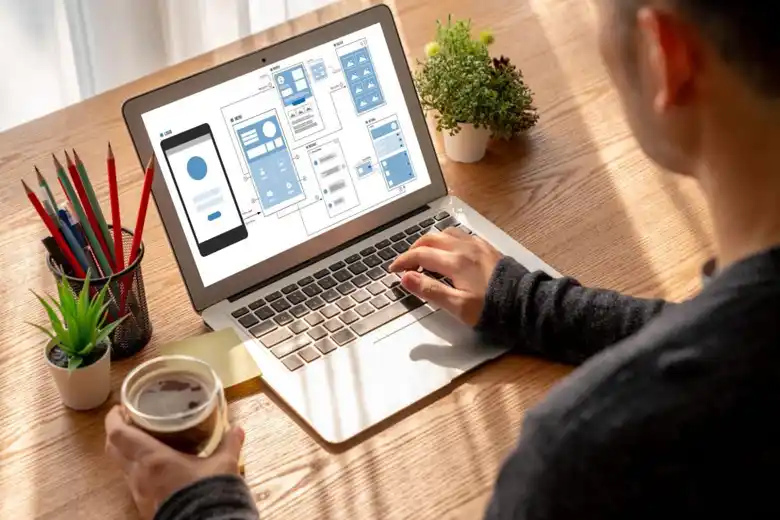Are you considering a career in UI design? If so, keep reading for the skills, tools, and processes that are the foundation of this rewarding profession.
The UI designer is responsible for the creation of visually appealing and intuitive digital interfaces that optimise and streamline the user experience delivered by a product or service. As more and more companies realize the value that positive user experiences have on conversions and sales, the demand for talented UI designers across every industry is steadily rising.
If you’re interested in learning about how you could start your career in UI design, then you’re in the right place. In this article, we’ll be covering everything you need to know about a career in this rewarding and creative field. From outlining the UI design process to the skills and tools you’ll need under your belt to succeed, by the end of this read you’ll be in a great position to start your learning journey in the field.
Contents:
- What does a UI designer do?
- What skills do you need to be a UI designer?
- What is the UI design process?
- What are the top tools used by UI designers?
- How to become a UI designer?
- Conclusion
Are you ready to learn more? Then, let’s dive in.
1. What does a UI designer do?
Typically working on a company’s design team, the UI designer is responsible for the visual aesthetics of a platform, app, or website, focusing on creating digital interfaces, elements, and icons that enhance the user experience and align with the brand’s tone and messaging. In addition to designing the layout, design elements, and interactive features of a digital product, the UI designer is also concerned with ensuring the entire aesthetic is as intuitive and seamless as possible to make it easy for users to navigate the interface and achieve their goals.
UI designers work closely with UX (User Experience) designers in gathering data on user behaviour, goals, and needs through extensive user research. These insights are then used to validate design decisions and inform any necessary improvements.

2. What skills do you need to be a UI designer?
If you’re hoping to work in the field of UI design, you’ll need to acquire a range of hard and soft skills to succeed. While some of these skills, particularly soft skills, are transferable from other professions, the more technical skills will require specific training via a UI design course or under the guidance of a professional.
Technical skills
Wireframing
One of the most important technical skills expected of a UI designer is the ability to create wireframes. Wireframing is the process of creating, either digitally or by hand, a visual representation of the interface’s structure and layout; it can be useful to think of it as a basic blueprint of a design without any of the details. These simple, low-fi drawings typically include shapes and lines to indicate where design elements such as buttons, menus, and text boxes should be placed and demonstrate how a user might navigate the site or app. The purpose of creating wireframes is to provide a template of the interface for the design team to work from and to provide stakeholders with an understanding of the intended structure and flow of the site. Design details such as colors, typography, and icons are provided later, and this will only happen once the whole team has signed off on the initial structure and flow provided in the wireframe/s.
Building Information Architecture
Information architecture refers to how the content of digital interfaces is organized, categorized, and structured. Knowledge of this process is essential for UI and UX designers as they are responsible for making it as easy as possible for users to find the information they are looking for. By structuring content in a logical, intuitive, and familiar fashion, as dictated by information architecture best practices, the UI and UX design teams enable users to meet their goals with greater ease. There are numerous benefits to creating a content hierarchy as part of the information architecture process: it enhances the user experience, improves accessibility, reduces cognitive load, and facilitates more effective user-system interactions.
Interaction design
Interaction design is concerned with the creation of meaningful and user-focused interactions between users and digital interfaces. Expertise in this area is therefore key for UI designers, who seek to enhance how users engage with and experience websites and apps. Interaction design for the UI designer involves looking closely at the areas where users and interfaces interact, such as buttons, forms, and navigational elements and designing layouts and elements that ensure interactions and responses are both predictable and intuitive while increasing overall levels of user satisfaction.
Research Skills
You may already be familiar with user research- when data and insights are gathered from target users and used to inform design decisions and improve the user experience of a product or service. In UI design, user research has the same intentions but focuses more heavily on finding out what users want or need from user interfaces specifically and how they interact with and respond to the visual elements of a design. This gives the designer a greater understanding of how users navigate an interface and helps them to identify potential obstacles or issues in real-time.
Prototyping
Ranging from low-fidelity prototypes like paper sketches, clickable PDFs, and whiteboard drawings, to hi-fidelity prototypes such as interactive mockups and dynamic, functional designs, prototyping in UI design seeks to create a simplified representation of an interface that assists the design team in visualizing the end product and testing its functionality. Whether hi-fidelity or low-fidelity prototypes are used, the goal is to simulate the user’s experience with the interface accurately enough to measure the success of the design. Prototypes can also assist in validating design concepts, gathering feedback, and iterating on designs with the goal of ensuring an effective user-centric final product.
Soft skills
Empathy
UI designers work closely with users, other designers, and project stakeholders to create design elements that are intuitive and help users and businesses meet their goals. In this context, empathy is crucial. A UI designer harnesses their empathy to better understand the feelings, behaviors, and perspectives of others, putting themselves in the shoes of their users to create interfaces that truly resonate with them and address their specific needs.
Communication
UI designers need excellent communication skills in order to communicate their design concepts to those of all knowledge levels, elicit valuable feedback from users, and collaborate with other team members and project stakeholders. Honed communication skills ensure that the team’s project goals are aligned, everybody understands what is required of them, and the workflow is as smooth as it can be.
Time management
Effective time management cannot be understated in UI design. Not only can those with good time management skills support the delivery of punctual project milestones, but can also be trusted with task prioritization and resource allocation. As a member of the design team, a UI designer who is able to manage their time well is also a reliable asset; rest assured their work will be delivered when promised, ensuring others in the team do not have to worry about postponing important dates for delivery.
Project management
Depending on the seniority of the UI designer and the size of the company or team, a UI designer’s role in a design project can involve much more than just designing the interface. Alongside the research, wireframing, and testing, project management can often fall to the UI designer leading the project. This involves planning, organizing, task delegation, and overseeing the project from start to end. With strong project management skills, a UI designer can manage their resources well, ensure a seamless UI design process, and make sure a project is on track to meet the company’s and design team’s objectives.

3. What is the UI design process?
The UI design process comprises several phases, beginning with user research and ending with handover to the development team. It’s an iterative process, with phases repeated where necessary to help the team gain clarity on design decisions.
Let’s dive into the details of each phase of the process and learn the purpose behind each.
i. User research
The first stage in the UI design process is user research. Using different research methods, such as user interviews, surveys, usability testing, and card sorting, a UI designer will seek to gather insights and data about the product’s target audience; their behavior, opinions, preferences, challenges, and goals. This qualitative and quantitative data is then used to inform design decisions and create an interface that fully meets user needs.
User research is an essential step in the UI design process as it enables the UI designer to really get to know who they are designing for and why. By asking users targeted questions, a UI designer is able to deepen their understanding of users and therefore enables them to create interfaces that are not just fully user-centric but also designed to solve the specific challenges of their users and enable them to meet their goals. This contributes to an overall positive user experience which leads to higher conversions and loyal, returning users.
ii. Competitor analysis
Competitor analysis in UI design and other areas such as marketing, UX design, and business strategy, involves cataloguing and evaluating the user experience strategies (or other strategies) of similar products or services in order to better understand the market your product is competing in. Typically, a competitor analysis will see the UI designer draw up a list of the strengths, weaknesses, and trends observed on a competitor’s interface, as well as areas for potential improvement or innovation. With these observations in mind, the UI designer will then seek to design the interface in a way that clearly differentiates itself from the competition.
This step is also an opportunity to learn from the mistakes of competitors and provide value in areas that the competitor does not. In a general sense, a competitor analysis provides UI designers with valuable insights into industry standards, interface conventions, and user expectations, as well as highlights potential opportunities for innovation.
iii. Creating wireframes and prototypes
Once the user research has been collected and a thorough competitor analysis has been undertaken, the UI designer is ready to start their first designs of an interface’s elements and layout.
As we’ve already discussed, wireframing is the creation of low-fidelity representations of an interface, with lines and shapes used to outline the structure and layout. With a focus on the arrangement of elements such as buttons and text boxes, UI designers shy away from detailed representations of design elements at this stage, concerning themselves instead with how users orient themselves and navigate their way through a website or app. This part of the UI design process sees the creation of a blueprint for the interface, a skeletal structure to be honed and improved before more details are added.
Once a wireframe has been signed off by the team, it’s time to start creating prototypes. In contrast to wireframes, prototypes are typically more detailed and interactive representations of the user interface. At this stage, the UI designer will incorporate colours, images, diagrams, and other visual details in order to realistically simulate the user experience they are hoping to create with the design. Using tools such as Figma, Sketch, or Adobe XD, the UI designer can create clickable buttons and interactive displays that closely resemble the final product. Once the prototype has been created, the UI designer can use it to gather user feedback, conduct tests, validate design decisions, and get a sign-off from management to move forward with development.
iv. Handoff to development
The final stage of the UI design process is handing over the design to the development team. This is when the UI designer provides detailed design specifications, high-fidelity design files, and any interactive prototypes that have been created during earlier phases. Additionally, individual design assets will be handed over and there may be a kickoff meeting between the two teams to facilitate effective collaboration. For the development team, these documents and communications provide the depth of detail they need to accurately recreate what the design team has envisaged.
At this stage, it's important that the UI designer communicates their concepts clearly. It is common to include, in handover documents, detailed style guides and component libraries which will guide the development team as they implement the design team’s ideas.
Handing over an interface design to be developed is not a one-way interaction, but an iterative process between designers and developers, involving ongoing communication between the two teams. This enables questions and concerns to be addressed, elements to be refined, and a smooth overall transition.
4. What are the top tools used by UI designers?

UI designers use a range of digital tools to help them throughout the design process, in particular, to assist in the creation of wireframes and prototypes. Let’s take a look at some of the most popular tools used by UI designers and learn about their key features.
Figma
Figma is a popular choice amongst UI designers as the prototyping tool enables collaborative interface design in real-time. By enabling multiple team members and stakeholders to contribute to a project simultaneously, the tool facilitates seamless collaboration as well as provides a central reference point and platform for the creation, sharing, and iteration of wireframes and prototypes.
Adobe XD
A versatile and collaborative UI design tool, Adobe XD facilitates the creation of interactive and visually compelling design prototypes. Whether a designer is conceptualizing a user interface, a website, or a mobile application, the tool offers real-time editing and collaboration alongside powerful prototyping features that streamline the entire workflow from ideation through to responsive prototype.
Sketch
Sketch is commonly used in UI design circles due to its simplicity and versatility. UI designers can use the tool to design scalable yet responsive interfaces and take advantage of the host of unique features the tool has to offer such as plugins, artboards, and symbols. One of the key advantages of Sketch over other UI design tools is its ability to adapt to varying design needs, enabling more effective collaboration and iteration.
InVision
Supporting the design process from end to end, InVison offers the full package for digital product design and prototyping. This advanced tool facilitates collaboration, the creation of animated prototypes, and the visualization and testing of user experiences. InVision’s unique benefit is its focus on enhanced communication between team members, streamlining the handoff to developers, and facilitating real-time collaboration.
Axure RP
Boasting features such as conditional logic, variables, and dynamic content, Axure RP is a robust UI design tool used by designers to build interactive, responsive, and dynamic prototypes. The software is known for its powerful capabilities in testing user flows and simulating interactions. It supports teams as they refine and streamline digital experiences as part of the UI design process.
Balsamic
When speed is of the essence, Balsamiq is the go-to choice for UI designers. This rapid wireframing tool has been created to assist in the creation of low-fidelity mockups of user interfaces, ideal for teams looking to get their sketches down quickly and collaboratively. Not the tool for diving into the details of a layout or design element, Balsamiq is instead a popular choice for its efficient iteration capabilities in early-stage projects as well as how it supports designers in the swift visualization of their design ideas.
UXPin
UXPin hosts a wide range of features that make it an invaluable asset to designers throughout each stage of the UI design process. The tool enables the creation of interactive wireframes and prototypes, supports usability testing, and bridges the gap between design and development teams. While the tool is known for its streamlined collaboration support, its assistance with creating and maintaining design systems and its project management capabilities should not be downplayed.

5. How to become a UI designer
If you’re interested in launching a creative and rewarding career in UI design, where do you start? Let’s look at some concrete steps you can take to ensure you have the knowledge, skills, and experience, you need to succeed.
i. Familiarize yourself with the theory
Your starting point as a student of UI design is to immerse yourself in the theory and fundamentals that support the practice. You’ll need to become well-versed in UI design principles, colour theory, typography, and composition. It will be valuable to have some foundational knowledge of UX design too as well as an understanding of how UX and UI designers work together to create positive user experiences. We’d recommend pursuing a UI design course, such as an online diploma or degree program, to ensure the groundwork of your UI design knowledge is properly laid.
ii. Get to know the tools
As we’ve seen, there are a host of UI design tools out there that provide invaluable assistance to UI designers throughout the process. Our advice is to get to know these tools as intimately as you can. Many of them are free or offer free trials, giving you the chance to play around with the different features and create your own projects while you are still learning. In an interview setting it will be important to outline which tools you are familiar with and your experience with them, so we’d suggest working on a complete project that allows you to be familiar with tools and eventually pick a tool that suits you best.
iii. Create a portfolio
While many UI design courses will assist you in the creation of your professional portfolio, for those who do not opt for a formal course it is even more important to put together a coherent body of work. You’ll want to emphasize your problem-solving skills and your attention to the user experience and showcase any UI-related projects (for your own practice, or for others) that you have completed. Many employers will be impressed by those who show what they have learned from each project, so don’t shy away from throwing light on what you might do differently next time, what went well, and what could have been done better. Annotate screenshots of your wireframes and prototypes to explain your decision-making process and highlight the tools you used along the way. For reference, you can take a look at the Game Creators Community Platform Project by AND learner Aromal Jose Baby
iv. Stay up to date
With the software available to UI designers improving and developing all the time, it’s important that you are able to stay ahead of the changes. Reading blogs on UI design, listening to industry podcasts, and chatting regularly with your network will keep you in the loop of what new technology is available and how it might benefit your work. Similarly, you’ll want to stay ahead of trends in the field. Trends in user behaviour are changing all the time so you’ll want to perform regular user research and keep an eye on the competition to stay aware of what your users might be expecting from the interface you design.
v. Build a network
Building a professional network is a key part of carving out a career in any field. Whether online or offline, this community can provide valuable feedback on your work, contribute to your learning and professional growth, and let you know of job opportunities as and when they arise. To build a network in UI design, look out for internships in design teams or take on freelance or voluntary jobs. Not only will these experiences help you build on your skills and expertise, but they’ll also provide opportunities for meeting other UI design professionals who could become a part of your network.
Conclusion
In this article, we’ve outlined not just what a UI designer does, but the skills, processes, and tools needed to excel in this increasingly in-demand role. Along with steps for launching a career in the field, we’ve provided a rounded guide for starting your own learning journey and offered concrete suggestions to help you build the UI design skills, portfolio, and experience that employers will be looking for in their candidates.
If you’re ready to take your first step towards a career in UI design, we’d suggest heading over to our course pages and checking out the AND Academy UI design diploma which offers expert teaching, hands-on assignments, career support, and a job guarantee.
Next Steps:
We hope this guide to UI Design skills, tools, and processes will equip you with the information you were seeking. In case you need further help, here are some additional resources you can consider:
- Watch this session by Shiva Viswanathan, Design Head of Ogilvy Pennywise, and Naman Singh, Product Experience Designer at RED.
- Talk to a course advisor to discuss how you can transform your career with one of our courses.
- Pursue our UX UI Design courses - all courses are taught through live, interactive classes by industry experts, and some even offer a Job Guarantee.
- Take advantage of the scholarship and funding options that come with our courses to overcome any financial hurdle on the path of your career transformation.
Note: All information and/or data from external sources is believed to be accurate as of the date of publication.










